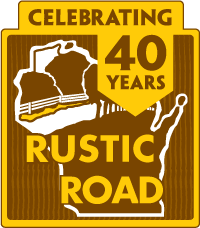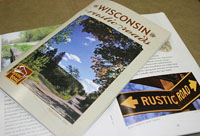Wisconsin's Rustic Roads: a positive step backward
There are 117 designated Rustic Roads spanning more than 669 miles through 59 counties. “We encourage people to explore Wisconsin Rustic Roads, no matter what the season,” said Wisconsin DOT Secretary Mark Gottlieb. “We are proud of the program’s 40 year history and pleased to see Rustic Roads in the statewide spotlight this year.”
- Rustic Road 116, St. Croix County
- Rustic Road 117, Waushara County
The Wisconsin Department of Transportation (WisDOT) and the Wisconsin Department of Tourism are sponsoring a Rustic Roads Photo Contest to commemorate the upcoming 40th anniversary. The window for submitting photos is now closed. Winners will be announced in fall of 2015.
Creation
The Wisconsin Legislature established the Rustic Roads program in 1973 to help citizens and local units of government preserve what remains of Wisconsin's scenic, lightly traveled country roads.
Unique brown and yellow signs mark the routes of all officially-designated Rustic Roads. These routes provide bikers, hikers, and motorists an opportunity to leisurely travel through some of Wisconsin's scenic countryside. For motorcyclists, Wisconsin offers a special Rustic Roads award program.
A small placard beneath the Rustic Roads sign identifies each Rustic Road by its numerical designation within the total statewide system. Each Rustic Road is identified by a 1- to 3-digit number assigned by the Rustic Roads Board. To avoid confusion with the State Trunk Highway numbering, a letter "R" prefix is used such as R-50 or R-120. The Wisconsin Department of Transportation (WisDOT) pays the cost of furnishing and installing Rustic Roads marking signs.
An officially designated Rustic Road shall continue to be under local control. The county, city, village or town shall have the same authority over the Rustic Road as it possesses over other highways under its jurisdiction.
A Rustic Road is eligible for state aids just as any other public highway.
What is a Rustic Road?
To qualify for the Rustic Road program, a road:
- should have outstanding natural features along its borders such as rugged terrain, native vegetation, native wildlife, or include open areas with agricultural vistas which singly or in combination uniquely set this road apart from other roads.
- should be a lightly traveled local access road, one which serves the adjacent property owners and those wishing to travel by auto, bicycle, or hiking for purposes of recreational enjoyment of its rustic features.
- should be one not scheduled nor anticipated for major improvements which would change its rustic characteristics.
- should have, preferably, a minimum length of 2 miles and, where feasible, should provide a completed closure or loop, or connect to major highways at both ends of the route.
A Rustic Road may be dirt, gravel or paved road. It may be one-way or two-way. It may also have bicycle or hiking paths adjacent to or incorporated in the roadway area.
The maximum speed limit on a Rustic Road has been established by law at 45 mph. A speed limit as low as 30 mph may be established by the local governing authority.
What you can do...
As you drive around the Wisconsin countryside, think of roads you would like to see included as part of the Rustic Roads system. Inventory Rustic Road candidates in your area. Then follow up with talks to local residents and government officials.
Initiate and circulate petitions among resident property owners along your favorite road to have it designated a Rustic Road. Work with civic, recreational and environmental groups to publicize and encourage the success of the Rustic Roads program.
The application information page includes a letter to prospective applicants explaining the Rustic Roads Program, petition, description and resolution forms to use in working with local government officials, and the state administrative codes governing the program. More information can be obtained by contacting your town chairman, county highway commissioner, Rustic Roads Board members and by going to our contact information page.
Questions about the content of this page:
Jane Carrola, jane.carrola@dot.wi.gov
Last modified: January 29, 2015




